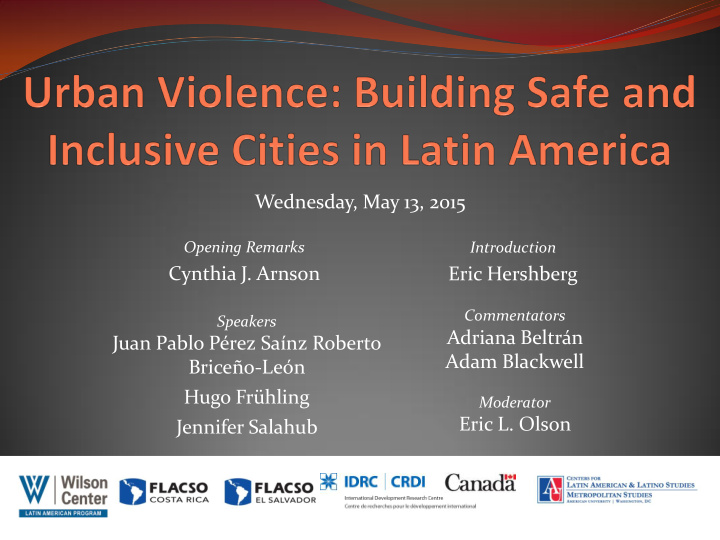



Wednesday, May 13, 2015 Opening Remarks Introduction Cynthia J. Arnson Eric Hershberg Commentators Speakers Adriana Beltrán Juan Pablo Pérez Saínz Roberto Adam Blackwell Briceño-León Hugo Frühling Moderator Eric L. Olson Jennifer Salahub
The research was focus of analysis the relationship between violence and social norms (formal and informal Institutions). The methodological tools were focus groups, in-deep interviews and participant observation. Research took place in four cities: Caracas, Ciudad Guayana, San Cristobal and San Antonio del Tachira. Fuente: Instituto Nacional de Estadística de Venezuela, INE.
The focus of research was the relationship between violence and institutions and it was carried out with residents of shantytowns and police and officers from Caracas and Guanana Fuente: Alcaldía Metropolitana de Caracas.
And herders of San Cristobal and shop retailers of San Antonio del Táchira Estado Táchira Población Densidad 1.348.331 117.9 hab./km² San Cristóbal Población Densidad 1.004.820 6.835,55 hab./km² Fuente: Alcaldía Metropolitana de Caracas.
Estado Bolívar / Ciudad Guayana Estado Bolívar Población Densidad 1.824.190 7,09 hab./km² Ciudad Guayana Población Densidad 1.080.00 320 hab./km² Fuente: Alcaldía Metropolitana de Caracas.
Área Metropolitana de Caracas
Estado Táchira / San Cristóbal
Estado Bolívar / Ciudad Guayana San Félix Puerto Ordaz
Caracas: Municipio Libertador/Sector Catuche
Caracas: Municipio Chacao/Sector La Cruz
Caracas: Municipio Libertador/Sector Catuche
Caracas: Municipio Sucre/Sector Julián Blanco-Petare
From the research we have been able to draw the following 12 conclusions. These can be useful for understanding the problem of urban violence and to design policies for safe and inclusive cities.
1 • Crime prevention does not work as an isolated policy, without a moral component to promote normative values and repressive component that enforces the law. - In Venezuela the action of law enforcement and police use was restricted because the authorities considered them as a right-wing government action. - In Venezuela the use of weapons and force as a legitimate means to achieve political or personal purposes was encouraged by government .
2 • Crime prevention should be linked to cultural and regulatory system. • Prevention may be material (employment, sports, food, housing and urban investment), but if not accompanied by a strong normative component, cannot achieve its purposes. It may even be counterproductive (“The food mission feeds the thugs”).
3 • Prevention should have an element of punishment to violators of the rule.
4 • The social representation of the law that has been in Venezuela and Latin America (rightly or wrongly) was to be a weapon of the rich and powerful. • In a situation of violence and the absence of state, as in Venezuela, what we have found is the opposite: law favors the weak and vulnerable, because they can not count on the private protection.
Área Metropolitana de Caracas
5 • Half Venezuelan cities (as well as an important part of the cities in Latin America) have been built and lived outside of formal law. • But in the absence of formal law, another informal institutions was created. These infomales institutions are the social pact. This informal institutions have not received adequate attention as a factor of social cohesion. • Its destruction, in the case of Venezuela, has been a factor that has favored the increase in violence in the city.
6 • When the state lacks its role in protecting the population and law enforcement, the population is between two models of social behavior in conflict. • On the one hand the formal model prescribed by law, that is not met. And on the other hand, the model of criminal, imposed by force and whose rules are met.
7 • When the state fails, appear external and informal forces that replaced in its function of protection and justice. Some of them have a negative significance, and other one positively. • Negative: The extrajudicial police action, taking justice into their own hands. • Negative: Armed vigilante groups, the groups called collective. • Positive: The response of family, school and religion as a mechanism of social control.
8 • The revitalization of traditional mechanisms of social control, such as family, school and religion, as substitutes mechanisms of the state, are going against the trends of modern society. Modern society has replaced the personal and religious mechanisms by formal, impersonal and secular social control.
9 • The societal responses have been an effort to restore the social pact through alternative mechanisms. The key players in this process have been women in roles of mothers, teachers and religious (nuns).
10 • The mechanisms used as "ceasefire pacts", "promoting peace mothers", "urban social agreements" have been ways to create a set of rules of consensus and moral strength. • A grassroots social pact.
11 • These mechanisms have limited effectiveness if they do not have support of the police or some coercive force.
12 • Any public policy that aims to promote safe and inclusive cities should strengthen formal and informal regulatory system. • In designing public policies, local authorities should take into account women as key players, and the role of mothers, school and religion.
Recommend
More recommend